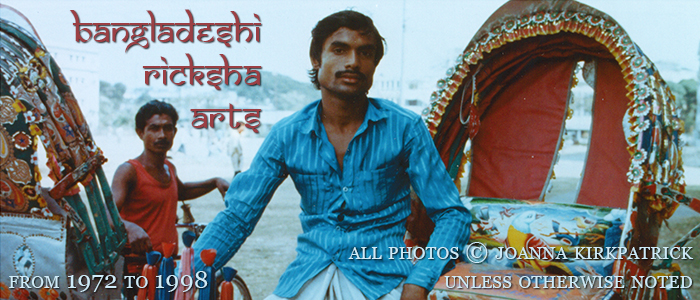

The Huntington Archive is grateful to Joanna Kirkpatrick for offering her outstanding photos of ricksha art as an exhibition on our website.
All text and imagery in this section © Joanna Kirkpatrick unless otherwise noted.
Associated Sites
The Ricksha Arts of BangladeshBangladeshi Arts of the Ricksha
Dhaka’s ricksha art fades in motor age
Rickshas in Dhaka Today
Introduction
Bangladesh, a country about the size of the US state of Wisconsin, was originally part of Bengal, India, under the British colonial empire of the 18th and 19th centuries. It became East Pakistan after Indian independence from Britain in 1947, when the subcontinent was partitioned between the two new nations of India and Pakistan. Despite almost thirty years of foreign-influenced economic development since its separation from Pakistan in 1971, Bangladesh maintains rich cultural traditions in the arts.
This exhibition is dedicated to celebrating one of Bangladesh's unique popular arts, the paintings and decorations on the three-wheeled cycle ricksha -- or "rickshaw", as spelled in English dictionaries. This site is based on my anthropological field visits to Bangladesh between 1975 and 1998, when I traveled about, took photos, and interviewed people. Ricksha arts cannot be assigned to any static "genre". They are popular as opposed to "fine" arts. They appropriate multiple forms which include folklore, classical art elements, and commercial forms. They also reflect the economic globalization process, which is occurring all over the world today, in their fascination with movie stars and narratives, with US disco during the seventies, with foreign travel scenes and fancy red sports cars.
About the author
Joanna Kirkpatrick, PhD UCB 1970 (Prior degrees Stanford and Yale). Cultural and Social Anthropologist. South Asia is my regional area of studies, both India and Bangladesh. Since my first fieldwork in Punjab, India in 1965-66, I have published in the fields of medical anthropology, women studies, and popular art in Bangladesh. All photo images, unless otherwise noted, are by the author. The International Folk Art Museum in Santa Fe, N.M. holds my 1987 collection of ricksha arts--both panels and hoods.
AUTHOR'S NOTE: I spell it the way it is spelled and pronounced in Bengali, ricksha with a long 'a' on the end. Bengali has the 'aw' sound, but it is distinctly not the sound at the end of this word in Bengali! As an anthropologist, I insist on "pc": phonetic correctness! Ideally, it would read: 'riksha' or 'riks_a'. But that would be too much to expect from English readers who expect 'ik' to be written 'ick'. Since writing 'ick' does not alter the sound, whereas writing '-shaw' does alter the sound, I've written it as 'ricksha'.
